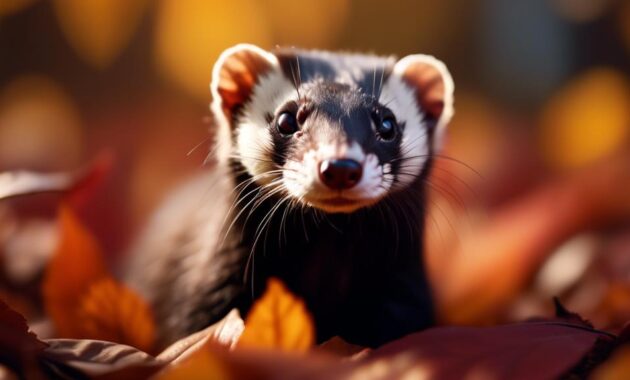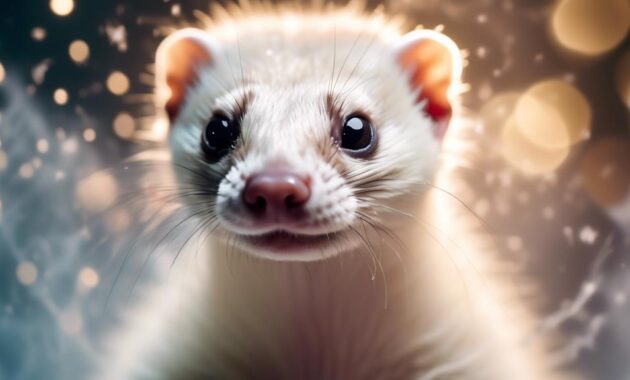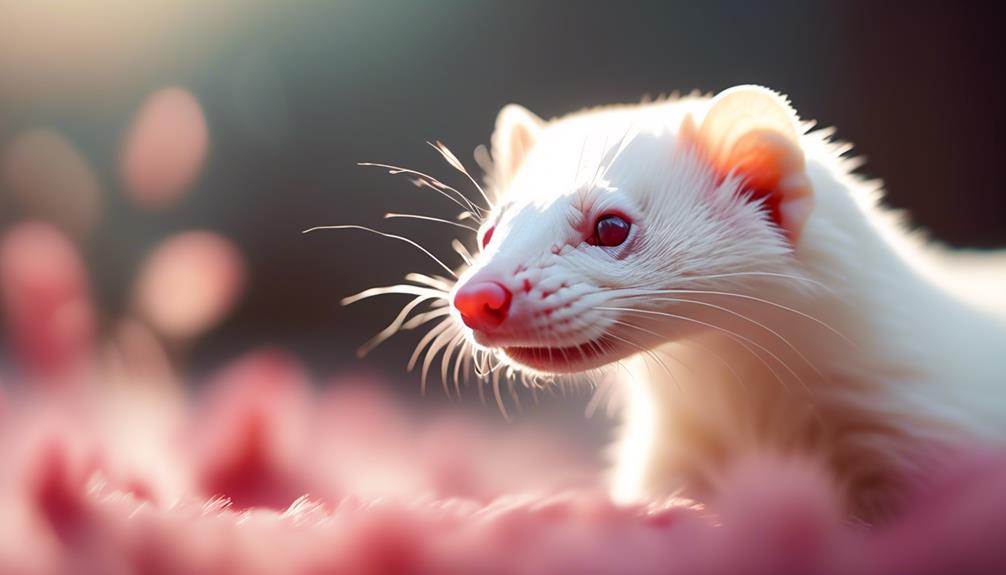
Are you ready to unravel the enigmatic world of albino ferrets and discover the secrets behind their unique genetics and health challenges?
Step into a captivating realm where mysteries await, as we explore the fascinating characteristics of these elusive creatures and delve into the science behind their striking albinism.
Prepare to be intrigued by the complexities that lie beneath the surface, as we shed light on the rare albino ferrets and their intriguing journey through the world of genetics and health.
Curiosity awaits; are you ready to embark on this adventure?
Key Takeaways
- Albino ferrets have a physical mutation that prevents the production of color pigments in their skin, hair, and eyes.
- Both parents must carry the recessive genes related to albinism for the condition to arise.
- Albino ferrets are prone to health issues, particularly in the eyes and skin, due to the absence of melanin.
- Albino ferrets can experience optokinetic deficits, affecting their eye movements and ability to track moving objects.
Albino Ferret Genetics
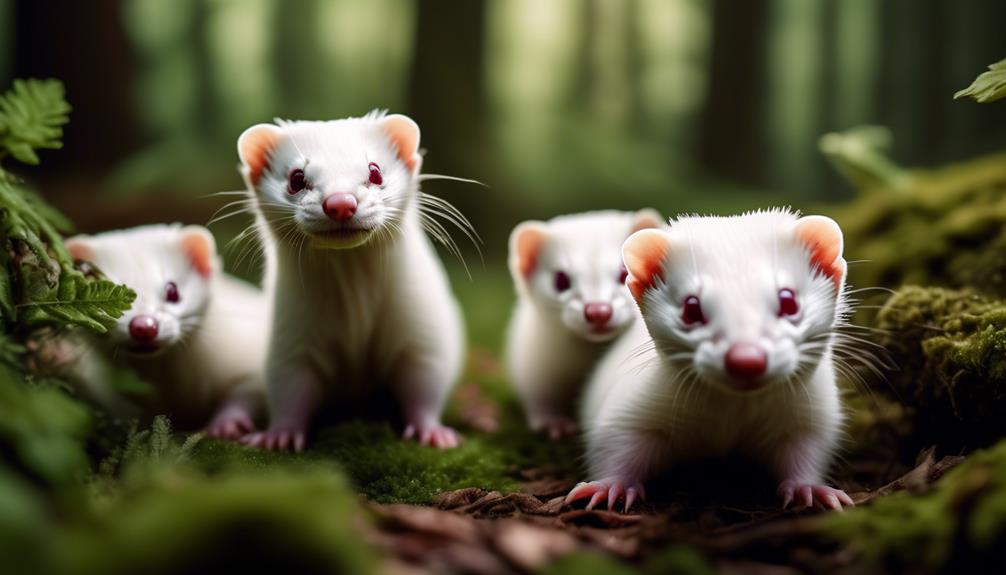
Albino ferret genetics play a crucial role in determining the presence of albinism in these animals. To have albino offspring, both parents must carry the recessive genes related to albinism.
The frequency of albinism in ferrets varies, with estimates ranging from 1 albino ferret per 10,000 normally pigmented ferrets to one million. Albinism affects keratin-based body parts, such as hair, skin, and scales, as well as the eyes. Full albinism results in pink or red eyes, while leucistic albinism causes blue eyes in ferrets.
There are no substantial distinctions between albino domestic ferrets and wild ferrets. Albinism can affect all ferrets similarly, regardless of their living environment. Domestic albino ferrets are more prevalent due to their historical role in hunting and the ease of spotting them.
Albinism and Ferret Health
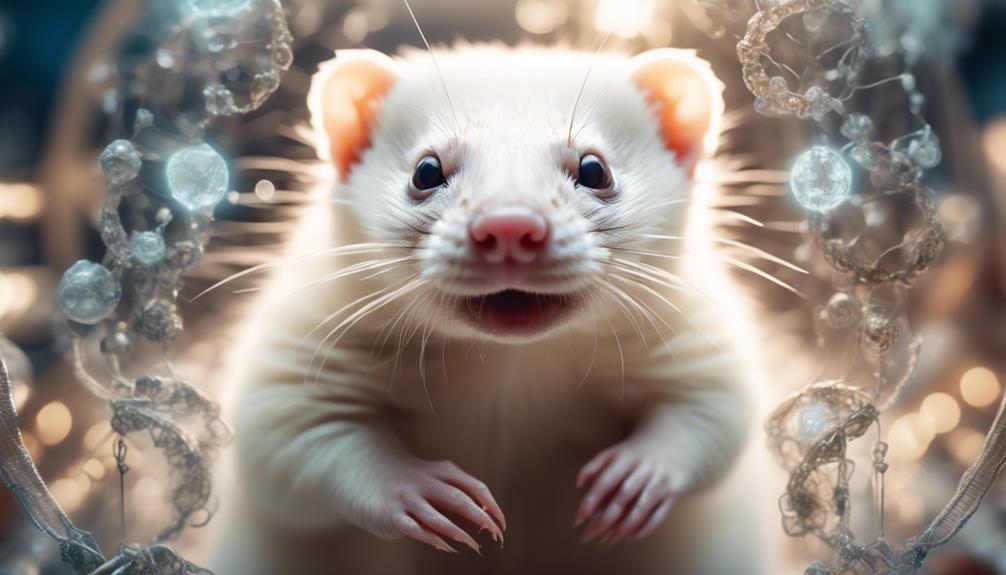
Albinism in ferrets can have significant implications for their overall health and well-being. Here are some important points to consider:
- Vulnerable Eyes and Skin: Due to the lack of melanin, albino ferrets are more susceptible to skin sensitivities and visual impairments. The absence of pigmentation makes their skin more susceptible to damage from harmful UV radiation. Visual impairments can vary in severity, with full albinos being most at risk.
- Specific Health Problems: Albino ferrets commonly experience skin sensitivities and visual impairments. The severity of these conditions can vary depending on the type of albino ferret. Partial albino ferrets may have fewer vision problems compared to full albinos, while leucistic albino ferrets may have blue eyes and fewer visual issues.
- Optokinetic Reaction (OKR): Albino ferrets may have optokinetic deficits, affecting their eye movements and ability to track moving objects. While they retain some visual capabilities, they struggle with objects moving in an incoherent pattern.
- Lifespan: Albino ferrets can live around eight years, similar to other ferrets. The condition of albinism doesn't typically impact their lifespan. However, lifespan variation can occur among different species affected by albinism.
Distinctions Between Domestic and Wild Albino Ferrets
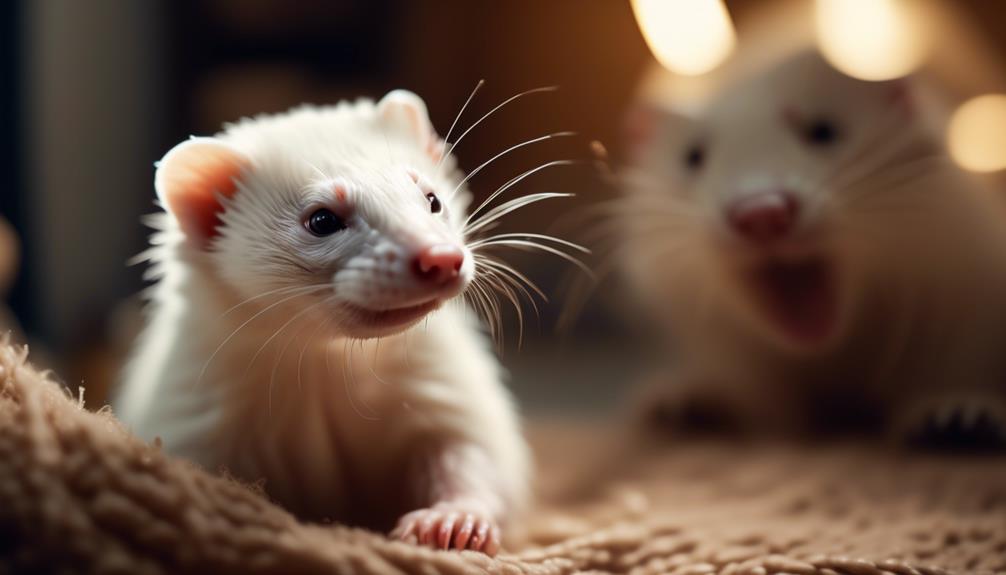
When comparing the characteristics and health implications of albino ferrets, it's important to understand the distinctions between domestic and wild populations. In reality, there are no substantial differences between albino domestic ferrets and their wild counterparts. Albinism can affect all ferrets similarly, regardless of their living environment.
However, wild albino ferrets may face unique challenges such as poor eyesight, difficulty in spotting danger, reproductive difficulties, and increased vulnerability to predators and sunburns. Domestic albino ferrets, on the other hand, are more prevalent due to their historical role in hunting and the ease of spotting them.
In domestic settings, white coat colors and albinism tend to be kept in genetic lines. Overall, while the basic characteristics of albino ferrets remain the same, their living environment can influence the challenges they face.
Common Health Issues in Albino Ferrets
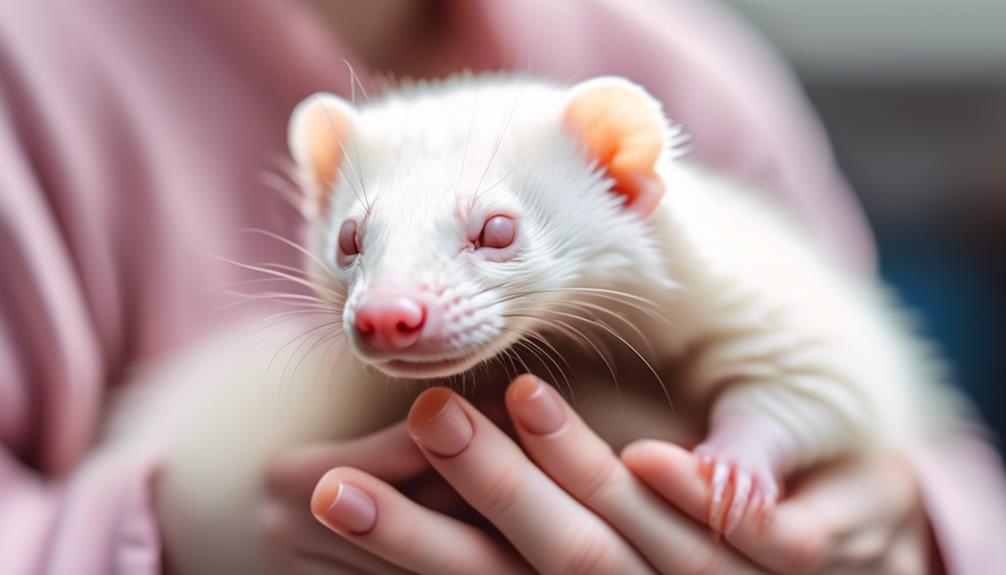
Skin sensitivities and visual impairments are common health issues in albino ferrets. These conditions arise due to the absence of melanin, a pigment that protects the skin and eyes from harmful UV radiation. The severity of these issues can vary depending on the type of albino ferret.
Here are the specific health problems that albino ferrets may experience:
- Skin sensitivities: Albino ferrets are prone to skin problems because of the lack of pigmentation. They've a higher risk of sunburn and are more susceptible to irritations and infections.
- Visual impairments: Albino ferrets may have difficulty tracking moving objects due to their compromised vision. Full albinos are most at risk, while leucistic albino ferrets with blue eyes may experience fewer visual issues.
- Optokinetic deficits: Albino ferrets may struggle with eye movements, especially when trying to track objects moving in an incoherent pattern. However, they can still perceive objects moving cohesively in a single direction or pattern.
- Lifespan: Albino ferrets generally have a similar lifespan of around eight years compared to other ferrets. The condition of albinism itself doesn't typically impact their lifespan.
Skin Sensitivities in Albino Ferrets
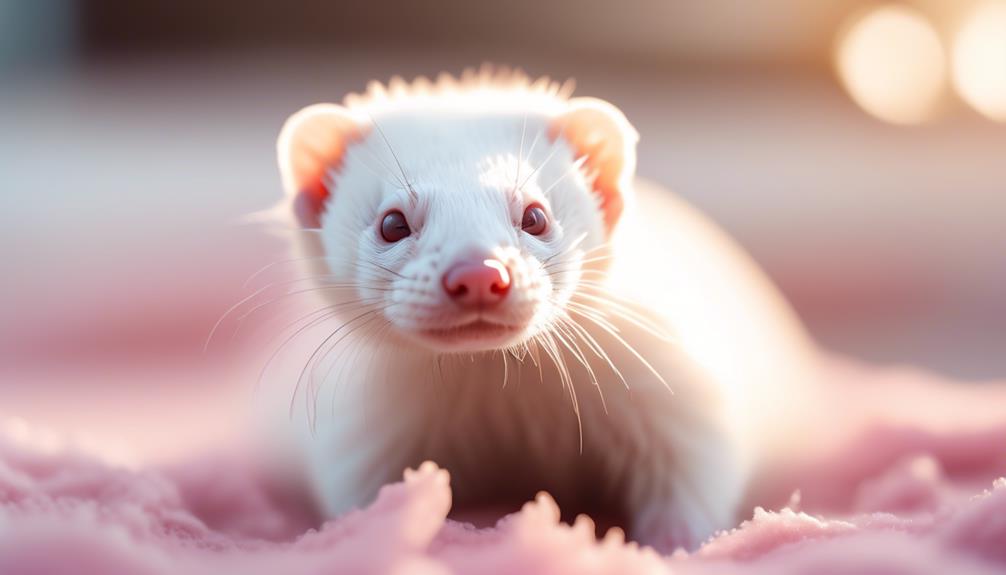
Albino ferrets are particularly susceptible to skin sensitivities due to their lack of melanin. Melanin is a pigment that helps protect the skin from harmful UV radiation and other external factors. Without melanin, albino ferrets have extremely sensitive skin that can easily become irritated or sunburned. They're more prone to developing skin conditions such as dermatitis or allergies.
It's important to provide albino ferrets with proper care and protection to minimize their exposure to potential irritants. This includes using sunscreen specifically designed for ferrets, providing a safe and shaded outdoor environment, and using hypoallergenic grooming products. Regular check-ups with a veterinarian can help monitor and manage any skin sensitivities or conditions that may arise in albino ferrets.
Visual Impairments in Albino Ferrets
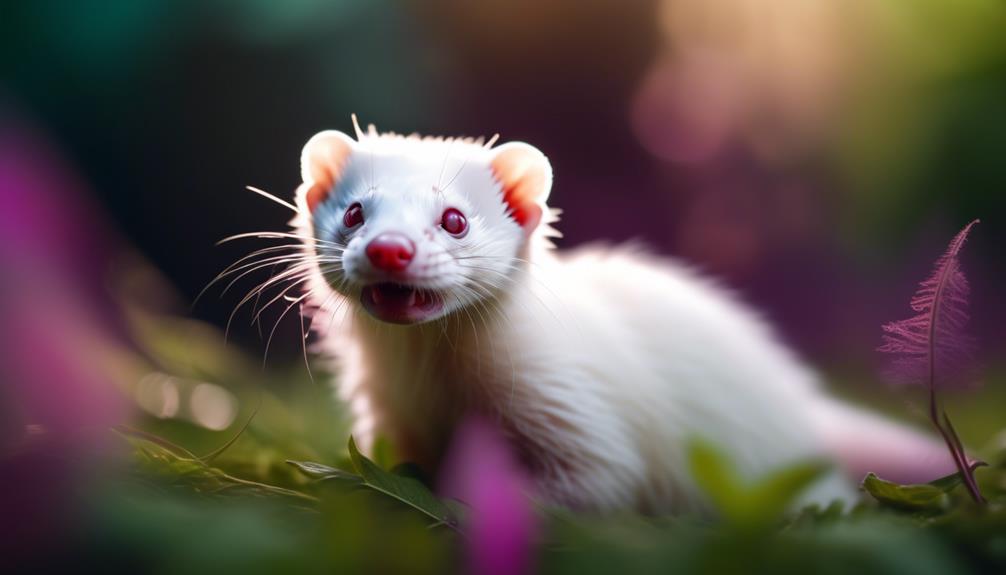
Visual impairments are a common challenge faced by albino ferrets, affecting their ability to see clearly and track moving objects. Here are four important points to understand about visual impairments in albino ferrets:
- Albino ferrets, especially full albinos, are most at risk for visual problems. The absence of melanin in their eyes leaves them more susceptible to vision issues.
- Partial albino ferrets may have fewer visual problems compared to full albinos. Leucistic albino ferrets, with blue eyes, may also experience fewer visual impairments.
- Visual impairments in albino ferrets can vary in severity. While they retain some visual capabilities, they struggle with tracking objects that move in an incoherent pattern.
- Albino ferrets can track objects that move cohesively in a single direction or pattern. However, their optokinetic deficits become more noticeable when attempting to track moving objects.
Understanding these aspects of visual impairments in albino ferrets is crucial for providing appropriate care and support for these unique animals.
Specific Health Problems in Albino Ferrets
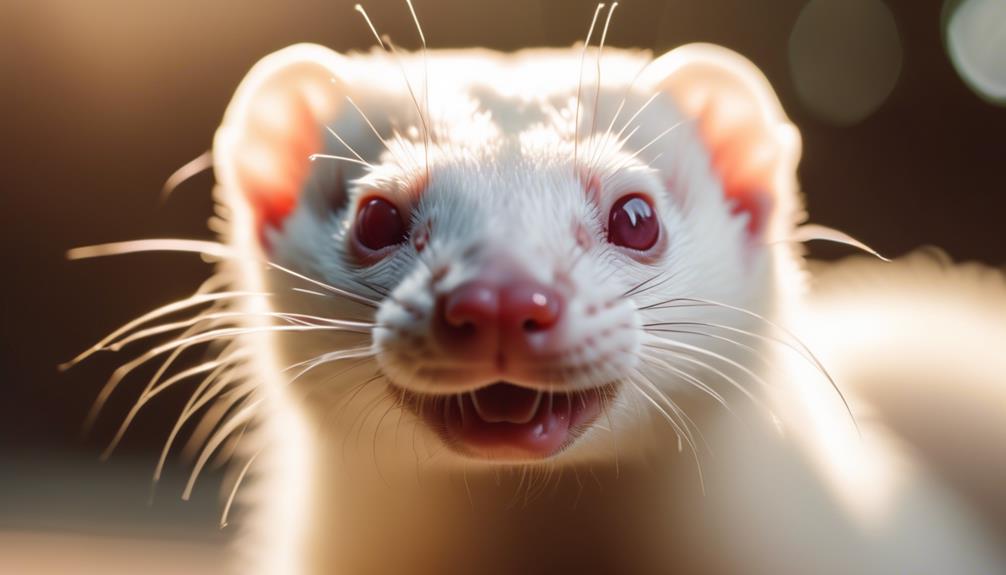
One common health concern in albino ferrets involves their susceptibility to skin sensitivities and visual impairments. Due to the absence of melanin, albino ferrets are prone to skin problems, such as irritations and sunburns. The lack of pigmentation makes their skin more vulnerable to harmful UV radiation.
Additionally, albino ferrets often experience visual impairments, which can affect their ability to track moving objects. The severity of these conditions can vary depending on the type of albino ferret. Partial albino ferrets may not have significant vision problems, while full albinos are most at risk. Leucistic albino ferrets, with their blue eyes, may have fewer visual issues compared to pink- or red-eyed ferrets.
It's essential for albino ferret owners to provide proper care and protection to minimize the impact of these health problems.
Optokinetic Reaction in Albino Ferrets
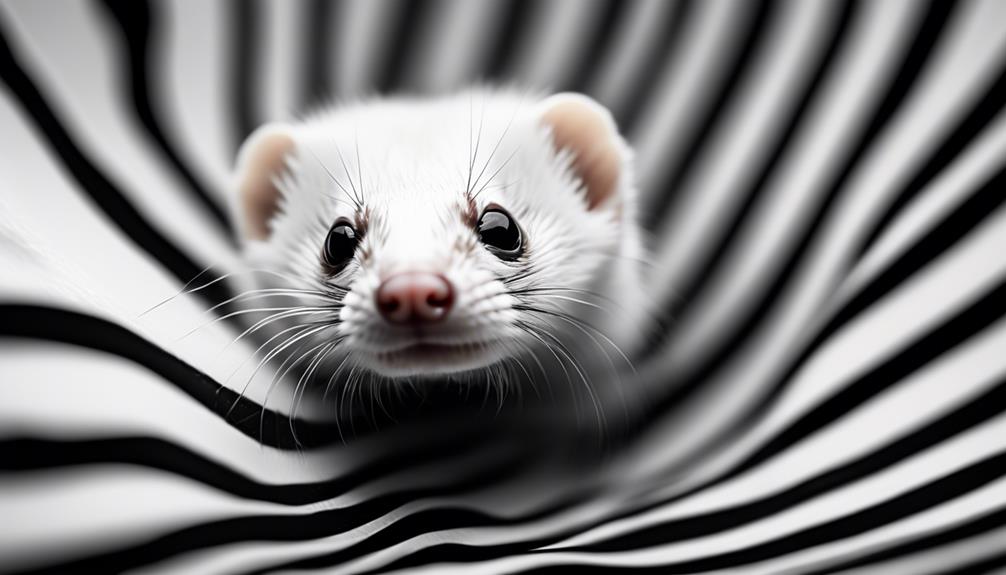
Albino ferrets may experience deficits in their ability to track moving objects due to optokinetic reaction. This condition affects their eye movements and can make it more challenging for them to follow objects in motion.
Here are four key points about the optokinetic reaction in albino ferrets:
- Optokinetic deficits: Albino ferrets may have difficulty tracking moving objects due to their impaired optokinetic reaction. This can result in a reduced ability to visually follow objects that move in an incoherent pattern.
- Retained visual capabilities: Despite their optokinetic deficits, albino ferrets still possess some visual capabilities. They can track objects that move cohesively in a single direction or pattern.
- Variations in albino ferrets: The severity of optokinetic deficits can vary depending on the type of albino ferret. Partial albino ferrets may not experience significant vision problems, while full albinos are most at risk.
- Lifespan: The condition of albinism doesn't typically impact the lifespan of albino ferrets. They can live around eight years, similar to other ferrets. However, it's important to note that lifespan can vary among different species affected by albinism.
Lifespan of Albino Ferrets
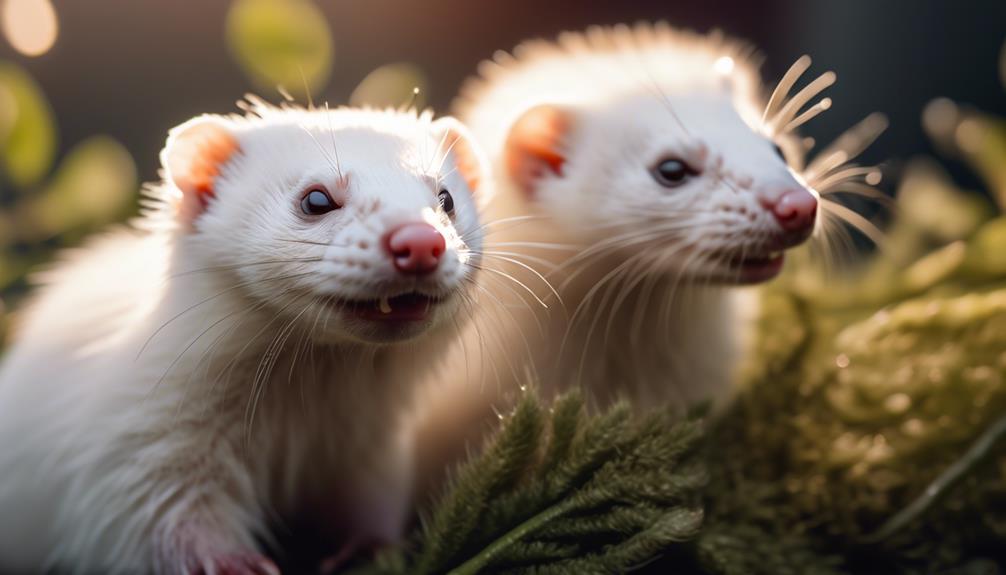
The lifespan of albino ferrets is comparable to that of other ferrets, typically around eight years. Despite their unique genetic condition, albinism doesn't significantly impact their lifespan. In fact, the albino ferrets' lifespan is similar to that of their normally pigmented counterparts.
Unlike other animals in different evolutionary groups, albino ferrets don't experience complications related to albinism that could shorten their lifespan. Ferrets and humans share physiological and medical similarities, which suggests a similar lifespan between the two species. However, it's important to note that there may be variations in lifespan among different species affected by albinism.
Nevertheless, if you have an albino ferret as a pet, you can expect them to live a fulfilling life for around eight years.
Frequently Asked Questions
Do Albino Ferrets Have Any Advantages or Unique Characteristics Compared to Normally Pigmented Ferrets?
Albino ferrets do not have any advantages or unique characteristics compared to normally pigmented ferrets. They may face health issues such as skin sensitivities and visual impairments due to the absence of melanin.
Can Albino Ferrets Be Bred With Normally Pigmented Ferrets to Produce Offspring With Mixed Pigmentation?
Yes, you can breed albino ferrets with normally pigmented ones to produce offspring with mixed pigmentation. The presence of the albino gene in one parent can result in a combination of pigmented and albino offspring.
Are There Any Specific Dietary Requirements or Considerations for Albino Ferrets?
There aren't any specific dietary requirements for albino ferrets, but it's important to provide them with a well-balanced and nutritious diet. Consult with a veterinarian to ensure their unique health needs are met.
How Can Albino Ferret Owners Protect Their Pets From Sunburn and Other Skin-Related Issues?
To protect your albino ferret from sunburn and other skin issues, limit their exposure to direct sunlight, provide shade, and use pet-safe sunscreen. Regularly check for any signs of irritation or sensitivity and consult a veterinarian if needed.
Are There Any Ongoing Research or Scientific Advancements in the Field of Albino Ferret Genetics and Health?
Yes, there is ongoing research and scientific advancements in the field of albino ferret genetics and health. Scientists are studying the genetics of albinism in ferrets and developing better ways to manage their health issues.
What are the Genetic and Health Considerations for Champagne Ferrets As Compared to Albino Ferrets?
When considering genetic and health factors, rare champagne ferrets take center stage compared to albino ferrets. Champagne ferrets have a unique gene that gives them their light coloring, while albino ferrets lack pigment entirely. This genetic difference can impact their health and potential health concerns, such as sun sensitivity and vision issues.
Conclusion
In conclusion, albino ferrets are fascinating creatures with unique genetics and health challenges. Their physical mutation inhibits the production of color pigments, leading to poor eyesight, reproductive difficulties, and increased vulnerability to predators. They're prone to skin sensitivities and visual impairments due to the lack of melanin.
Despite these challenges, albino ferrets continue to captivate us with their enigmatic nature. It's important to understand and care for their specific needs to ensure their well-being and longevity.


